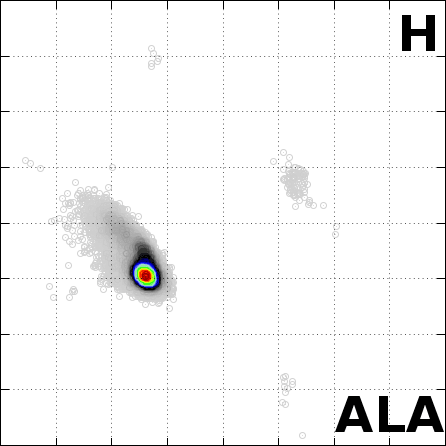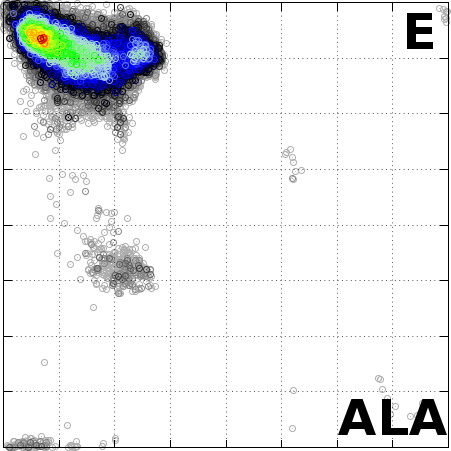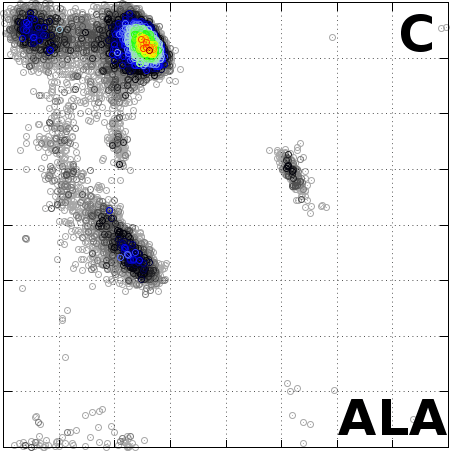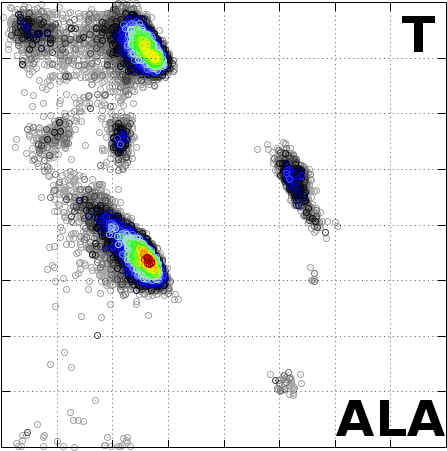APL
APL
Angle Probability ListOverview
The Angle Probability List (APL) represents the normalized frequency of observed pairs of amino acid residues and secondary structure in the Protein Data Bank. We combine the conformational preferences of amino acid residues (AA, torsion angles) in proteins with their secondary structure information (SS).
We selected a set of 6,650 protein structures from PDB. All 3-D protein structures were experimentally determined by X-ray diffraction with resolution ≤ 2.0Å and stored in PDB until December 2014. We remove all structures with R-factor greater than 0.2. If homologous protein chains with sequence identity at most 30% were found, only one of them was retained. We select only amino acid residues with b-factor ≤ 30Å2 and occupancy equal to 1. Similar parameters to filter PDB data were used before by Hovmoller and Ohlson (2002).
For more details please contact us: mdorn@inf.ufrgs.br




Download
Instructions
The APL.zip file contains all APLs arranged by the 20 standard amino acid residues (3 letter code) and eight different secondary structure assigned by STRIDE.
| Amino Acid | 3-Letter-Code |
|---|---|
| Alanine | Ala |
| Arginine | Arg |
| Asparagine | Asn |
| Aspartic acid | Asp |
| Cysteine | Cys |
| Glutamic acid | Glu |
| Glutamine | Gln |
| Glycine | Gly |
| Histidine | His |
| Isoleucine | Ile |
| Leucine | Leu |
| Lysine | Lys |
| Methionine | Met |
| Phenylalanine | Phe |
| Proline | Pro |
| Serine | Ser |
| Threonine | Thr |
| Tryptophan | Trp |
| Tyrosine | Tyr |
| Valine | Val |
| Secondary Structure | 1-Letter-Code |
|---|---|
| Alpha helix | H |
| 3-10 helix | G |
| PI-helix | I |
| Extended conformation | E |
| Isolated bridge | B or b |
| Turn | T |
| Coil (none of the above) | C |
Example:
File ALA_H_histogram.dat represents the APL for the Alanine (ALA) amino acid with alpha-Helix (H) secondary structure.
In each \*\_histogram.dat file, we have 4 major groups: PHI, PSI, Frequency, {OMEGA}.
When the amino acid residue has CHI angles they are represented as: PHI, PSI, Frequency, {OMEGA}, {CHI}'s.
Example:
ALA_H_histogram.dat
| PHI | PSI | Freq. | {OMEGA} |
|---|---|---|---|
| -94.000000 | 11.000000 | 0.000010 | {0: [169.7]} |
ASN_G_histogram.dat
| PHI | PSI | Freq. | {OMEGA} | {CHI-1} | {CHI-2} |
|---|---|---|---|---|---|
| -99.000000 | 11.000000 | 0.000240 | {0: [-176.0]} | {0: [-171.3]} | {0: [48.1]} |
When the number of occurrences grows, the number of {OMEGA} and {CHI}'s grows as well.
Example:
ALA_H_histogram.dat
| PHI | PSI | Freq. | {OMEGA} |
|---|---|---|---|
| -95.000000 | 20.000000 | 0.000019 | {0: [172.6, 173.5]} |
ASN_G_histogram.dat
| PHI | PSI | Freq. | {OMEGA} | {CHI-1} | {CHI-2} |
|---|---|---|---|---|---|
| -95.000000 | -16.000000 | 0.000480 | {0: [-175.5, -159.3]} | {0: [-68.3, -66.1]} | {0: [-51.5, -33.8]} |
When the number of occurrences grows but the values of {OMEGA} or {CHI}'s are different, sub-groups are made.
Example:
ALA_H_histogram.dat
| PHI | PSI | Freq. | {OMEGA} |
|---|---|---|---|
| -95.000000 | -5.000000 | 0.000019 | {0: [-179.1], 1: [172.0]} |
ASN_G_histogram.dat
| PHI | PSI | Freq. | {OMEGA} | {CHI-1} | {CHI-2} |
|---|---|---|---|---|---|
| -95.000000 | -11.000000 | 0.000480 | {0: [-176.6, -163.6]} | {0: [-79.8, -74.1]} | {0: [-23.1], 1: [131.0]} |
| PHI | PSI | Freq. | {OMEGA} | {CHI-1} | {CHI-2} |
|---|---|---|---|---|---|
| -91.000000 | 8.000000 | 0.000480 | {0: [-179.2], 1: [173.4]} | {0: [-76.7, -75.1]} | {0: [-13.8, -9.4]} |
| PHI | PSI | Freq. | {OMEGA} | {CHI-1} | {CHI-2} |
|---|---|---|---|---|---|
| -71.000000 | -24.000000 | 0.000480 | {0: [-176.1], 1: [175.3]} | {0: [-170.2], 1: [-68.8]} | {0: [-36.1], 1: [51.2]} |
Citing APL
If you use APL in a scientific publication, we would appreciate citations to the following paper:
BibTeX
@article{Borguesan:2015,
title = {{APL}: An angle probability list to improve knowledge-based metaheuristics for the three-dimensional protein structure prediction},
journal = "Computational Biology and Chemistry",
volume = "59, Part A",
pages = "142--157",
year = "2015",
issn = "1476-9271",
doi = "http://dx.doi.org/10.1016/j.compbiolchem.2015.08.006",
url = "http://www.sciencedirect.com/science/article/pii/S1476927115301250",
author = "Bruno Borguesan and Mariel Barbachan e Silva and Bruno Grisci and Mario Inostroza-Ponta and Márcio Dorn",
}